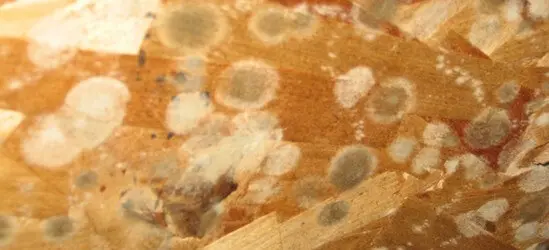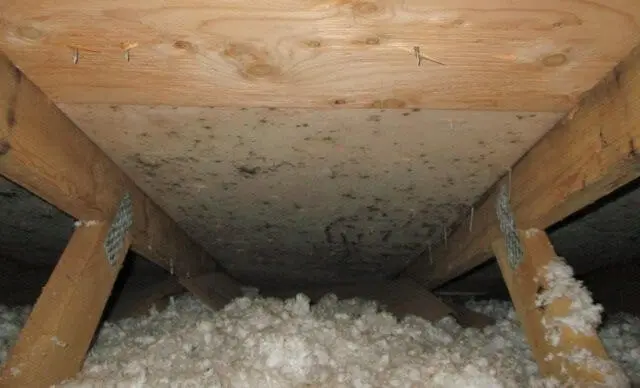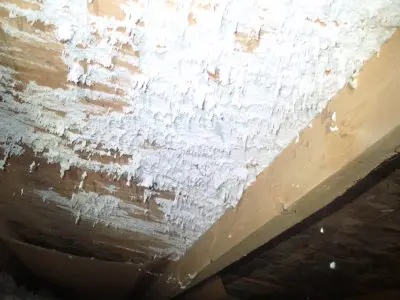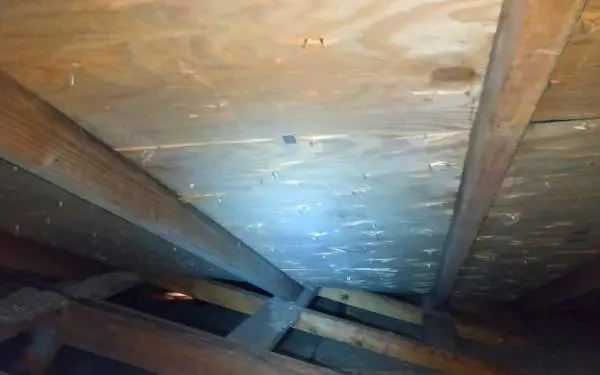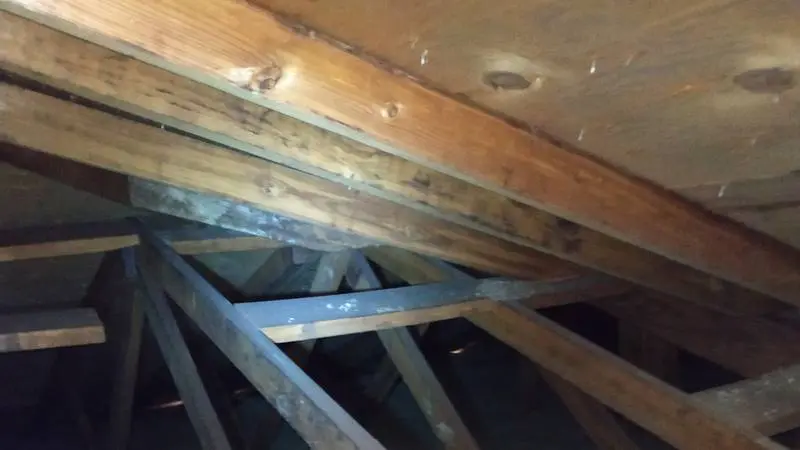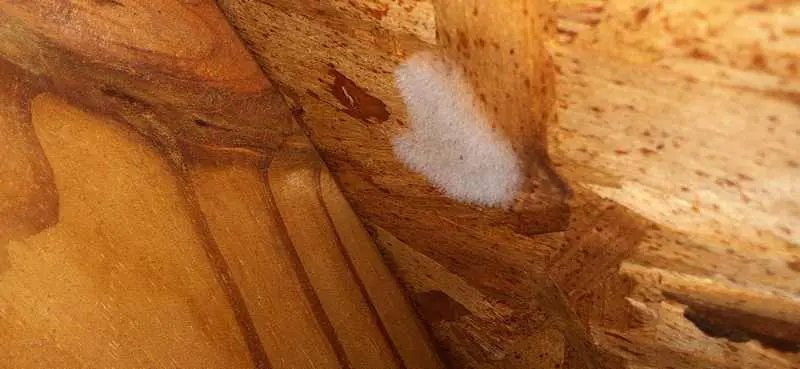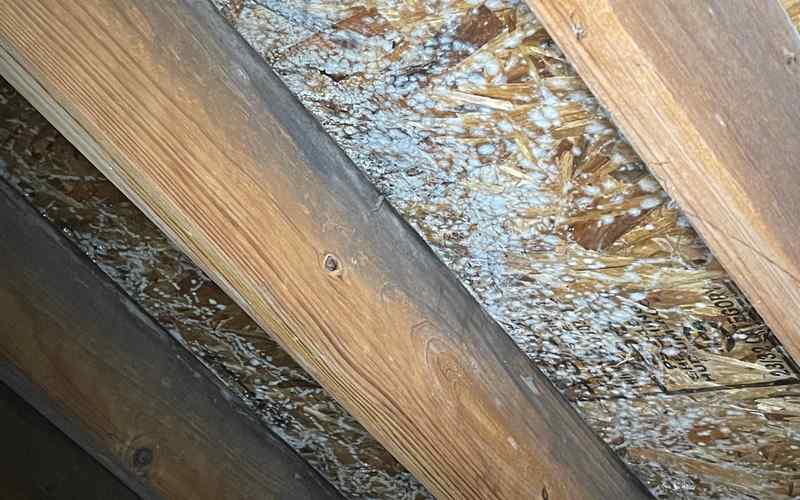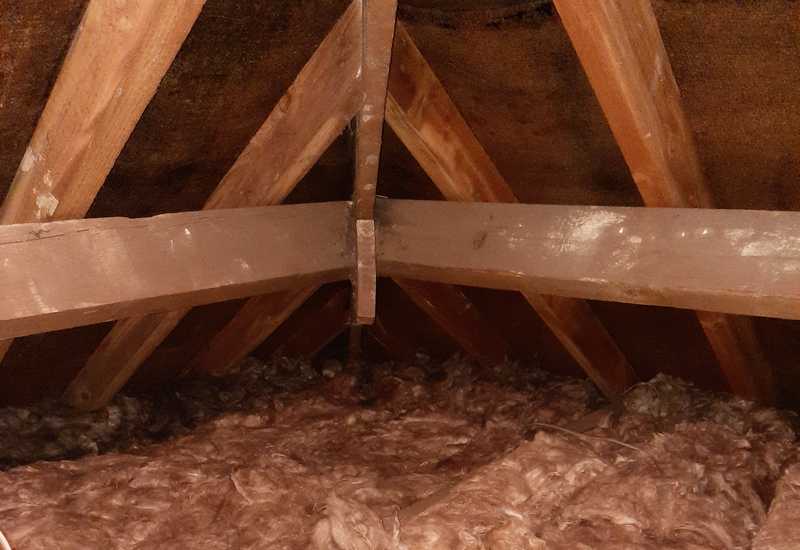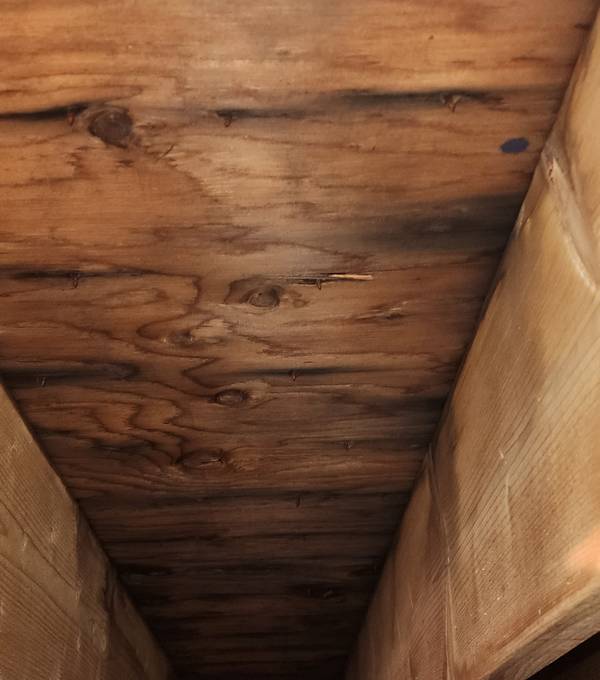Mold on Attic Sheathing
Mold growth on attic/roof sheathing is a common issue in cool climates, such as the Pacific Northwest. In the vast majority of cases, the mold growth is caused by condensation. This occurs when the temperature of the sheathing drops below the dew point, creating a thin layer of moisture on the substrate. If this happens regularly, mold spores will activate and begin to grow.
What does the mold growth typically look like?
Mold growth on the sheathing occurs in either a flat, low profile configuration or a fuzzy, 3 dimensional pattern. The flat, low profile growth can often look like soot or staining. In fact occasionally a home inspector will misidentify the mold growth as soot from a fire. Notice the dark staining in the first picture. This type of mold growth will not smudge or wipe off. The dark discoloration will remain long after the mold has stopped growing.
Below is an image of heavy 3-dimensional mold growth on the sheathing. Beneath the fuzzy growth, areas of staining can be observed as well. This type of attic mold is less common and typically easier to remediate. Because the staining is limited, a thinner layer of encapsulant can be applied.
Not all sheathing is equally mold resistant
Ironically, despite the many gains we’ve made in the building codes, we’ve still managed to install progressively worse and worse attic sheathing materials over the decades. Of course, the problem of mold growth is much more complicated than a simple choice of materials, involving ventilation, insulation, air sealing, etc. But our choices of materials haven’t made mold prevention any easier.
Skip Sheathing and Tongue & Groove.
For many years the sheathing material of choice was skip sheathing or tongue and groove. Both of these were natural wood products with excellent mold resistance. While mold growth can occur on these materials, it typically requires far more moisture and time for the growth to occur. We regularly encounter attics with skip sheathing that have very poor ventilation and yet, remarkably little mold growth. Part of this is due to the age of the homes and the general lack of air sealing that occurred when they were originally constructed. However, a large factor is simply natural wood’s resistance to mold growth.
Below is an unusual example of mold attacking the skip sheathing, while the plywood remains largely unaffected. Often this is a sign that the plywood has been replaced recently. The mold growth may have occurred years ago and has yet to attack the new plywood.

White Mold Growth on Attic / Roof Sheathing
Below is a more typical example of mold growth. Note the heavy staining and growth on the plywood. The original skip sheathing has much less growth.
Plywood Sheathing
Natural wood is expensive. Builders, forever looking to save a few bucks, began turning toward plywood roof sheathing. Though certainly superior to OSB, plywood inevitably provided a food source more conducive to mold growth than its more natural cousin. The reason is straightforward; as you compress wood into a laminate structure, the cell walls begin to break down. In a sense, this ‘pre-digests’ the wood for the mold growth, allowing for much quicker decay.
OSB Sheathing
OSB reigns as the most popular sheathing material in most markets today. Like the decision to move from natural wood to plywood, the move to OSB was motivated by price. Unfortunately, the enormous pressure used to create OSB breaks down the cell walls of the wood at a greater rate than plywood. As noted above, this allows mold to attack the fibers at a much quicker rate than other materials.
Uneven mold growth
This is where it gets weird. In some cases the mold growth will occur very prominently on one piece of sheathing, while the adjacent piece is completely clear. Two potential causes are possible here. First, the wood may have come from the factory with latent mold spores present in the wood. Once additional moisture was available, the mold starts to grow.
The second variable is the species of wood used in the plywood. Some woods are much more resistant to rot and fungal attacks. Even if conditions are conducive to mold growth (elevated moisture), plywood made from a fungal resistant wood will resist mold growth for quite a while.
Testing attic mold
In most cases, testing for attic mold is unnecessary. If you see growth or discoloration that looks like mold, it is very likely mold. Occasionally concrete staining from the original construction can look like mold. However, it can be easily determined by attempting to wipe it off.
But don’t we need to know what type of mold is in the attic?
No. The type of mold has no impact on the remediation procedure or the long term prevention. Whether it’s Stachybotrys or Cladosporium, they are both cleaned up in the exact same manner. Save the money you would spend on testing and put it towards prevention and remediation.
I insist on testing the mold – what sampling technique should I use?
I you simply must know the type of mold in your attic, the best technique is tape lift sampling. As the name implies, a small piece of lab tape is gently pressed against the suspected material. The tape is then placed on a glass slide and sent to a lab for analysis. Note – this will determine the genus, not the species of mold.
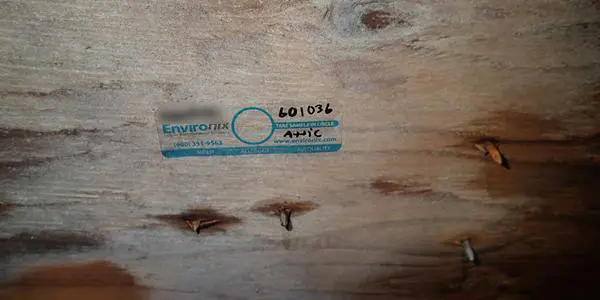
Acremonium mold growing on attic sheathing.
Removing mold growth from roof sheathing.
Mold remediation contractors use a variety of techniques to address attic mold growth, including dry ice blasting, hand sanding and encapsulation. The first two are effective, though often cost prohibitive. As you can imagine, the labor required to hand scrub every square inch of roof sheathing is quite significant. Additionally, encapsulation is still necessary, as the hand sanding and brushing will not remove the underlying stain left by the mold spores.
Dry ice blasting is an attractive, but expensive, choice. The technique uses solidified carbon dioxide beads to blast the surface material from the sheathing. The concept is similar to sand blasting, minus the mess. Unfortunately, dry ice blasting produces a large amount of carbon dioxide gas, which in a confined area, can lead to a drop in oxygen levels. This necessitates several safety measures that can quickly ruin the economic feasibility of the process.
Encapsulation addresses several of these problems in an efficient and cost-effective manner. We have more information on the subject of mold encapsulation on our mold treatment page.
What steps are necessary to prevent mold growth from returning to the roof sheathing?
Mold growth will return if the underlying moisture issues are not addressed. Typically, this involves increasing the roof ventilation and air sealing the ceiling of the top floor. Combining these two techniques both limits the influx of warm moist air and also helps remove the damp air that slips through. Exceptions do exist though. In some modern homes, the insulation levels are so high that no heat reaches the roof sheathing. You could have all the ventilation in the world and you’d still have condensation problems. Why? If the sheathing is as cold as the outside air, additional ventilation doesn’t really help. We need some radiant heat to escape into the attic to slightly warm the sheathing.
*Heads up – I earn a small commission on sales through Amazon links. This helps cover the expense of running the website (and answering your questions!)
Got a question? Ask it here and we'll post the answer below
Is this mold harmless to humans? What happens if I don't remove it. Maybe just paint over it with a sealer?
Mold growth in an attic will typically not affect the indoor air quality in the rooms below. This is due to the stack effect, which moves air upward through a home. Attic mold should be approached as a structural issue. Left unattended, the moisture and fungal growth will eventually degrade the roof sheathing. Painting or sealing it will not address the problem. The mold will simply grow on top of (and through) the layer of paint. You must address the underlying moisture issue in order to stop the mold growth. Often this is a combination of increased ventilation, air sealing the ceiling, lowering the indoor RH, etc.
Can you please tell me what this might be? I have this all over in my attic. Some spots are just patches here and there and others are big areas. I have obvious moisture stains in the attic and the roof is sagging and not properly installed. Does this look like mold?
This looks like light attic mold growth. If the roof is sagging/failing, I recommend contacting a roofer. The sagging can occur from leaks or excessive condensation. You’ll likely need additional roof ventilation, air sealing of the ceiling and improved ventilation inside the home. The latter is important because it lowers the amount of humidity that enters the attic space in the first place. This lessens the burden on the attic ventilation.
Does this look like something I should be concerned about and getting tested? Thank you.
It’s a bit difficult to determine from the photo. It appears you have light/moderate mold growth appearing on the framing and sheathing. Attic mold should be considered a building failure issue, not a health concern. Due to the stack effect (the concept of warm air rising in a home), mold issues in an attic do not impact the indoor air quality in the occupied area below.
I would further investigate your ventilation, air sealing, bathroom exhaust fans/ducts etc.
Had roof replaced and couple months later noticed this growing in attic.
Yes, this is mold growth. However, the amount of mold is extremely small and does not require remediation. If you start observing larger sections of growth, hire a reputable roofing contractor to investigate the roof ventilation.
A roofer looked in my attic saw black mold especially lower towards the soffit. He is telling me to replace the perimeter of the roof at a minimum, and possibley the entire roof.
It’s quite rare for mold growth to warrant the replacement of the sheathing. While it can look unsightly, it takes quite a while to structurally damage the sheathing. If you’re already due for a roof replacement, replacing a few sheets makes sense. If your roof is in good shape, I rarely recommend tackling the sheathing. Focus on improving the roof ventilation to ensure the mold growth does not continue.
I just had a roof replaced on my house ( tear off ) new osb sheathing and added on deck intake vents for ventilation along with ridge cap vents. Has not been a month and went into the attic and noticed almost all new osb has white fuzzy mold growth. Roofing company is supposed to come out next week to see what’s going on.
The amount of regrowth is high for only a month. Is there any chance the OSB was saturated during the reroof? I.e. was it rained on prior to install? This certainly would explain the regrowth in an otherwise dry attic. Also, I see signs of past growth (black/grey) on the adjacent framing. This indicates a long term moisture issue in the past.
Here are a few items I recommend investigating:
- Verify the qty of upper roof ventilation. RVOs should be installed every 4′-6′ just below the ridge line.
- Verify the sheathing/OSB was cut correctly to match the new vents. Often the vent holes don’t line up with the new vents, limiting the air flow.
- Soffit vents should be present in every other framing bay (typically every 4′). Check to ensure no insulation is blocking the soffit vents.
- Ensure all bathroom/kitchen exhaust ducts are properly connected to dedicated roof vent caps. Often these are accidentally disconnected during the reroof process.
My house is 1950 and I notice I have some white powder in timber trusses in loft, is this correct to say its condensation issue? If I will install vent tiles is this will resolve issue?
Yes, this is very likely due to condensation. This often occurs in older homes when they are retrofitted with additional insulation. Although it’s counter-intuitive, the extra insulation actually increases the likelihood of condensation and mold growth. This is due to the decrease in heat loss through the ceiling.
In a home with limited ceiling insulation, heat will radiate through the insulation and elevate the temperature of the roof sheathing. While inefficient from an energy consumption standpoint, this heat eliminates or greatly reduces condensation. If you add insulation to this scenario, this heating effect is eliminated and the roof sheathing will cool dramatically. In time, this can lead to condensation and mold growth. This is especially problematic in older homes that were designed with relatively limited ventilation.
In your case, I recommend adding upper roof venting (either externally baffled ridge vent or RVOs) and ensuring you have adequate soffit ventilation.
Hello, my house was built in 2016 and apparently not insulated all that well, is this something i need to be concerned about? I had an insulation company come out today and blow in some cellulous insulation. do I need to have any of this remediated ?
The amount of mold growth is very light and doesn’t necessitate professional remediation. Ironically, adding insulation won’t reduce the amount of mold growth. All things being equal, it will actually increase the likelihood of mold. This is because the insulation reduces the amount of heat reaching the roof sheathing. The lower temperature increases the possibility of condensation and subsequent mold growth.
The primary concern is the ventilation of the roof. Based on the photo, it appears the soffit vents are blocked by the insulation batts. I would ensure your soffit vents are clear. Insulation contractors are notorious for blocking the soffit vents.






